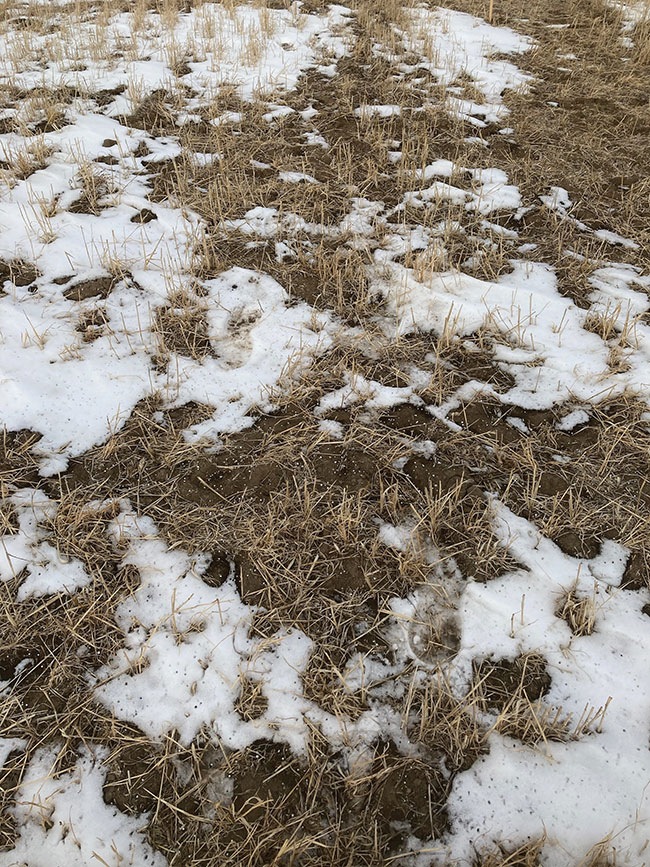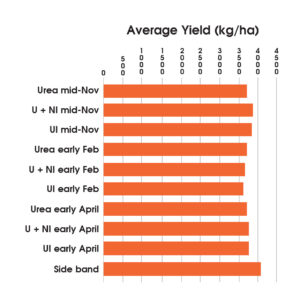
Features
Agronomy
Research
Broadcast urea on snow suffers large losses
Economic losses from broadcasting urea on frozen or snow-covered soil was high.
October 11, 2023 By Bruce Barker
 Broadcasting urea on snow resulted in high economic losses.
Broadcasting urea on snow resulted in high economic losses. Broadcasting urea is a nitrogen (N) management strategy that is gaining popularity because it can be done much more quickly than banding in a separate pass or side-banding during seeding. A growing number of farmers are broadcasting urea on frozen or snow-covered soil during the non-growing season. Recent research has found that the economic losses from this practice can be almost $89 per acre ($220/ha).
“For some parts of the province, it is a very common practice because they tend not to get a lot of snow, and applications can be made very quickly. This speed of application, along with the reduction in energy required by not having to put the fertilizer in the ground, makes broadcasting on snow an attractive practice,” says Kim Stonehouse, a crops extension specialist with the Ministry of Agriculture in Tisdale, Sask.
Stonehouse headed up a two-year study at seven AgriArm sites in Saskatchewan:
- Conservation Learning Centre (CLC) – Prince Albert,
- East Central Research Foundation (ECRF) – Yorkton,
- Indian Head Agricultural Research Foundation (IHARF) – Indian Head,
- SK Irrigation Crop Diversification Corporation (ICDC) – Outlook,
- Northeast Agriculture Research Foundation (NARF) – Melfort,
- South East Research Farm (SERF) – Redvers, and
- Wheatland Conservation Area (WCA) – Swift Current.
The Outlook site was under irrigation, while the others were all dryland sites. The project started in November 2020 and ended in December 2022. The project’s objectives were to develop Saskatchewan-specific data showing the loss of production and economic risks associated with broadcast applications of N fertilizers on frozen and snow-covered soils.
Hard red spring wheat was seeded at all sites. All plots received N application rates based on soil tests. A phosphorus (P) fertilizer application was applied at a rate of 30 lbs P2O5 per acre (34 kg P2O5 per ha).
Fall soil residual N was high at ECRF at 69 lbs/ac (78 kg N/ha) and SERF at 67 lbs/ac (76 kg N/ha) in 2020-21. The other sites had low soil residual N ranging from three to 12 lbs/ac (3 to 13 kg N/ha). Values were similar in 2021-22.
Ten N application treatments were compared:
- 1x Urea broadcast mid-November,
- 1x Super U (urease + nitrification inhibitor) broadcast mid-November
- 1x Anvol (urease inhibitor) treated Urea broadcast mid-November,
- 1x Urea broadcast early February,
- 1x Super U broadcast early February,
- 1X Anvol treated Urea broadcast early February,
- 1x Urea broadcast early April,
- 1x Super U broadcast early April,
- 1x Anvol treated Urea broadcast early April, and
- Spring side band 1x urea at seeding.
At some sites in some years, the soil at the mid-November application was not frozen, but it was frozen for the early February application date. All sites had snow cover to a varying degree for the first and second application timings, but only the CLC site had any significant snow cover during the April application.
Drought masked yield responses
Drought impacted the results in 2021 at CLC, ECRF, NARF and WCA with significantly lower May to August precipitation than the long-term average. In 2022, CLC and WCA had below-normal rainfall, and SERF had significantly higher rainfall.
No significant differences in average grain yield between treatments were found in 2021 at CLC, ECRF, IHARF and NARF. At SERF, the side-banded treatment gave the statistically highest yield at 51 bu/ac (3445 kg/ha). In irrigation at ICDC, side-band also had the highest grain yield at 90 bu/ac (6020 kg/ha).
In 2022, CLC, ECRF, NARF and SERF had no significant differences in grain yields between treatments. AT IHARF, WCA and ICDC under irrigation, side-band once again had the statistically highest yield. For example, the side-band yield at IHARF was statistically the highest at 86.5 bu/ac (5806 kg/ha) compared to the poorest yield of 65 bu/ac (4383 kg/ha) for the untreated urea applied in early February.
In his final research report, Stonehouse says there were several reasons that contributed to a lack of significant yield differences at some of the sites. Drought limited N response, and the below-average precipitation and low yields meant that the high N application rates were likely able to supply the crop with the necessary N for all treatments regardless of losses.
“This research showed that losses happen even in dry years. However, some sites applied greater amounts of fertilizer in anticipation of greater growing season precipitation or had significant soil residuals that were able to meet the crop demand regardless of losses,” explains Stonehouse. “Had there been the potential for greater production, the yield and protein differences between banded nitrogen and that which was broadcast on frozen or snow-covered soils would have been significantly larger in favour of the banded fertilizer because nitrogen losses would be more pronounced with broadcast applications.”
This theory is supported by the highest yields at ICDC under irrigation with side-banded N at seeding.
Enhanced efficiency fertilizer ineffective
Stonehouse also says the addition of the enhanced efficiency fertilizer products with urease inhibitors or urease plus nitrification inhibitors provided a trend to higher average yield compared to untreated broadcast urea, but the differences were not significant for any site-year, and yields were lower than side-banded N yields.
Grain protein highest with side-band N
At 12 out of 15 sites, significant differences in protein levels were observed, with nine of those 12 showing the highest grain protein content when nitrogen was side-banded at seeding. Untreated urea consistently had the lowest protein content. On average, side-banding nitrogen at seeding resulted in the highest average protein content. However, nitrogen applications made in early February consistently exhibited the lowest average protein levels. Although broadcast applications in mid-November and early April led to improved average protein content, they did not reach the same level as when nitrogen was side-banded at seeding, according to Stonehouse.
Treating Urea with an inhibitor
Treating urea with an inhibitor tended to enhance grain protein content, yet no significant differences were observed between bare urea and urea treated with an inhibitor for any of the three application timings.
Large economic losses
Economic returns were determined by comparing the yield difference between each broadcast treatment and the side-banded N treatment, and then multiplying this yield difference by the value of CWRS spring wheat, set at a price of $10.80 per bushel ($397.48 per tonne) in 2023. The additional cost of using an Enhanced Efficiency Fertilizer (EEF) treatment was also factored into the calculations, with Anvol priced at $128 per tonne and Super U at $150 per tonne. However, broadcast and side-band application costs were not included in the calculations.
Over the span of two years across all sites, the economic losses in comparison to side-banded N were substantial. The losses ranged from $50 per acre ($123 per hectare) with mid-November application of urea plus urease inhibitor (UI), to $88 per acre ($218 per hectare) with the early February application of urea plus UI. In favourable growing conditions at ICDC and IHARF in 2022, the losses were even higher, reaching $323 per acre ($799 per hectare) with the early February application of urea plus nitrification inhibitor (NI).
Average Economic Difference relative to side banding
| Treatment | Average Economic Difference
|
| Urea mid-Nov | -145/ha (-$59/ac) |
| U + NI mid-Nov | -123/ha (-$50/ac) |
| UI mid-Nov | -130/ha (-$53/ac) |
| Urea early Feb | -145/ha (-$59/ac) |
| U + NI early Feb | -205/ha (-$83/ac) |
| UI early Feb | -218/ha (-$88/ac) |
| Urea early April | -145/ha (-$59/ac) |
| U + NI early April | -167/ha (-$68/ac) |
| UI early April | -162/ha (-$66/ac) |
| Side band | 0 |
While the drought certainly impacted the results, better growing conditions could have led to even higher yield and economic losses associated with broadcasting N on frozen or snow-covered soil.
“Higher product costs and greater yield potentials could greatly amplify these economic losses. This was demonstrated very clearly at the irrigated site where water was not the limiting factor,” says Stonehouse. “Given that urease and nitrification inhibitors did not significantly reduce these losses, practices that involve banding nitrogen into the soil should be encouraged over broadcasting it onto frozen or snow-covered ground.”
